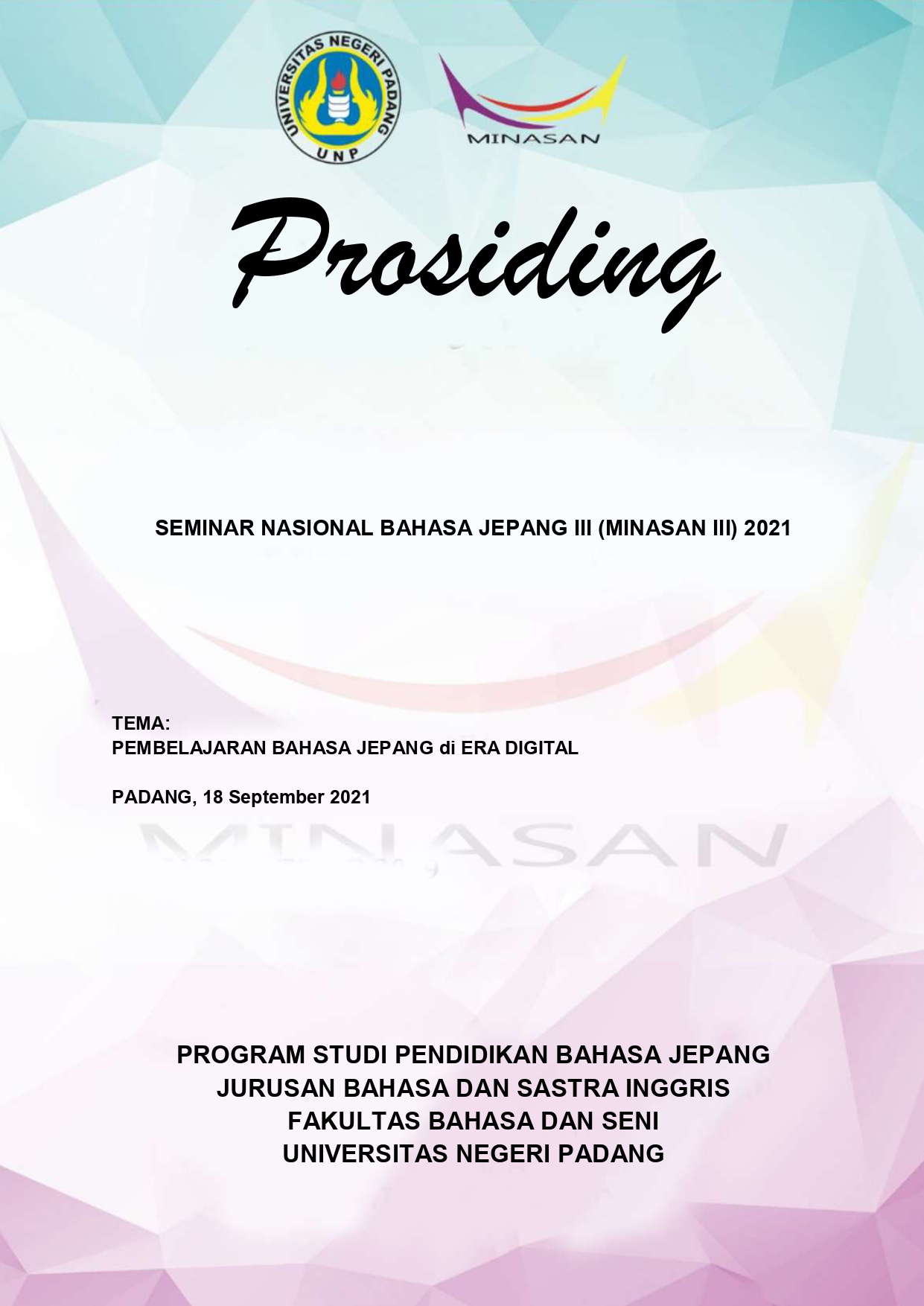Verba ‘Memberi’ dalam Bahasa Jepang: Kajian Metabahasa Semantik Alami
Kata Kunci:
Japanese language learning, linguistic studies, synonymsAbstrak
The verb 'give' can be matched with many words in Japanese. In addition to the verbs watasu, ageru, yaru,
kudasaru, and kureru which are learned at the elementary level, many other words have the meaning of 'to
give' in Japanese, including juyo suru, kizou suru, kifu suru, ataeru, okuru, sashiageru. This article discusses
the use of semantic linguistic theory, namely Natural Semantic Metalanguage to dissect the meaning
configuration of three 'give' verbs in Japanese, namely kizou suru, kifu suru, and juyo suru. Although these
three verbs are not taught in the basic level book of Minna no Nihongo and are not included in the core
vocabulary list for students, through the application of Natural Semantic Metalanguage theory, the semantic
structure of the three verbs can be mapped and explicated. The method of providing data is using the
observation method by utilizing the corpus data. The results of the analysis show that the three verbs have 11
components of meaning. However, it can still be distinguished based on the type of object that accompanies
the verbs. It can be concluded that these three verbs do have closeness. However, of these three verbs, the
verb juyo suru and kizou suru are more closely related in meaning. This is evidenced by the exact explication
between the verbs juyo suru and kizou suru. By knowing the meaning configuration of each verb, students can
choose the correct verb to produce an acceptable and natural speech according to the context of its use as a
native Japanese speaker.
Referensi
Alifah, R. F. (2020). Kala dan Aspek pada Kata Kerja Iku dan Kuru dalam Bahasa Jepang. JLA
(Jurnal Lingua Applicata), 3(2), 132. https://doi.org/10.22146/jla.57096
Backhouse, A. E. (2016). Using Japanese Synonyms. Cambridge University Press.
Bias, S. (2021). Learning Japanese in Comparison to Romantic and Germanic Languages
[University of Tennessee Chancellor‟s Honors Program].
https://trace.tennessee.edu/utk_chanhonoproj
Darlina, L., & Dyah, W. (2017). Afiks Verba Derivatif Bahasa Jepang (Kajian Tipologi Linguistik).
Jurnal ASA, 4, 41–50.
Faisal, S. (2021). Analisis Kontrastif Verba yang Menyatakan Arti Main dalam Bahasa Jepang dan
Bahasa Indonesia (Kajian Sintaksis dan Semantik) [Universitas Pendidikan Indonesia].
http://repository.upi.edu/58995/
Goddard, C. (2017). Ten Lectures on Natural Semantic Metalanguage. Brill Online.
https://doi.org/https://doi.org/10.6084/m9.figshare.c.3950929.v1
Maekawa, K., Yamazaki, M., Ogiso, T., Maruyama, T., Ogura, H., Kashino, W., Koiso, H.,
Yamaguchi, M., Tanaka, M., & Den, Y. (2014). Balanced corpus of contemporary written
Japanese. Lang Resources & Evaluation, 345–371. https://doi.org/10.1007/s10579-013-9261-0
Malayu, S. M., & Muliadi, Y. A. (2020). Japanese Verba Analysis on The Use of Duration , Intensity
, and Frequency by Indonesian and Malaysia Teachers TALENTA Conference Series Japanese
Verba Analysis on The Use of Duration , Intensity , and Frequency by Indonesian and Malaysia
Teachers. 3(4). https://doi.org/10.32734/lwsa.v3i4.1147
Meidariani, N. W. (2019). Makna Verba Bahasa Jepang. Jurnal Ayumi, 6(2), 148–162.
https://doi.org/https://doi.org/10.25139/ayumi.v6i2.2131
Saifudin, A. (2021). Verba Beri-Terima dalam Bahasa Jepang. Japanese Research on Linguistics,
Literature, and Culture, 3(1), 59–68. https://doi.org/10.33633/jr.v3i1.3436
Sudaryanto. (2015). Metode dan Aneka Teknik Analisis Bahasa. Sanata Dharma University Press.
Sutedi, D. (2001). Analisis makna verba Agaru dan Noboru. FUSII, 8, 1–4.
http://file.upi.edu/Direktori/FPBS/JUR._PEND._BAHASA_JEPANG/196605071996011-
DEDI_SUTEDI/Artikel-Makalah_(PDF)/01_Agaru_dan_Noboru.pdf
Tanaka, Y., Sawada, S., Shigekawa, A., Makino, A., & Mikogami, K. (2017). Minna no Nihongo
Shokyu II Dai 2-Han: Honsatsu. Lintas Cipta Pustaka.
Trahutami, S. I., & Lee, N. C. R. (2021). Makna Verba Bahasa Jepang “ Tsukuru ” Dan Bahasa
Indonesia “ Membuat .” Kiryoku: Jurnal Studi Kejepangan, 5(1), 136–144.
https://doi.org/https://doi.org/10.14710/kiryoku.v5i1.136-144
Wierzbicka, A. (1996). Semantics: Primes and Universals. Oxford University Press.
Unduhan
Diterbitkan
Terbitan
Bagian
Lisensi
Hak Cipta (c) 2022 I Gede Oeinada

Artikel ini berlisensi Creative Commons Attribution 4.0 International License.







